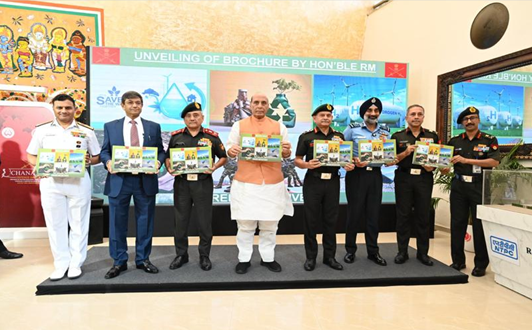NTPC and Indian Army Collaborate to Launch Solar Hydrogen-Based Microgrid at Chushul, Ladakh
First-of-its-Kind Project to Ensure Stable Power for Remote Army Outposts and Advance Green Hydrogen Initiatives in Ladakh.

- Country:
- India
In a landmark move for sustainable energy in remote, high-altitude areas, NTPC has partnered with the Indian Army to establish a Solar Hydrogen-based Microgrid at Chushul in Ladakh. The groundbreaking ceremony was conducted today through video conferencing, with Hon’ble Defence Minister Shri Rajnath Singh laying the foundation stone. The event included senior officials from the Ministry of Defence, the Chief of Defence Services, NTPC CMD, and senior Army representatives.
Reliable Power in Extreme Conditions
NTPC’s innovative Solar Hydrogen Microgrid System is designed to produce 200 kW of round-the-clock power, even during Ladakh’s severe winters, where temperatures can plummet to -30°C at an elevation of 4,400 meters. By harnessing green hydrogen as a storage medium, this microgrid aims to replace diesel generators currently used in the off-grid Army stations, ensuring a stable power supply in these challenging terrains.
This system will offer several advantages, including:
Reduction of Carbon Emissions: The shift from diesel gensets to solar hydrogen microgrids will significantly lower carbon emissions, supporting India’s carbon neutrality goals.
Enhanced Resilience and Energy Independence: This project eliminates dependence on fuel logistics, which is challenging in remote areas affected by limited road connectivity and severe weather.
Scalability for Future Needs: The technology is adaptable to various applications, allowing it to serve a range of energy demands across similar remote outposts.
The Solar Hydrogen Microgrid aligns with Ladakh’s high solar irradiance levels and benefits from low temperatures to optimize green hydrogen production. This grid system, maintained by NTPC for 25 years, marks a crucial step toward decarbonizing energy supply within the Indian defence sector in remote regions.
Supporting Ladakh’s Carbon-Neutral Vision
Recently, NTPC introduced hydrogen buses in Leh as part of its trials to move towards carbon neutrality. In addition to setting up a hydrogen refueling station, the company will establish a solar plant and five fuel cell buses for intracity routes in Leh. This aligns with NTPC’s goal to enhance Ladakh’s renewable energy footprint and lead India’s green hydrogen adoption.
NTPC is actively pursuing 60GW of renewable energy capacity by 2032, aiming to be a leader in green hydrogen technology and energy storage. The organization is currently working on numerous green projects, including hydrogen blending, carbon capture, electric buses, and energy-efficient NTPC townships across India. This project at Chushul not only strengthens India’s energy security in border areas but also highlights the nation's commitment to sustainable growth and decarbonization.
This collaboration with the Indian Army exemplifies NTPC’s dedication to innovative energy solutions and brings India a step closer to its carbon neutrality targets, setting a global example of green initiatives in challenging, high-altitude terrains.
- READ MORE ON:
- Indian Army
- NTPC










